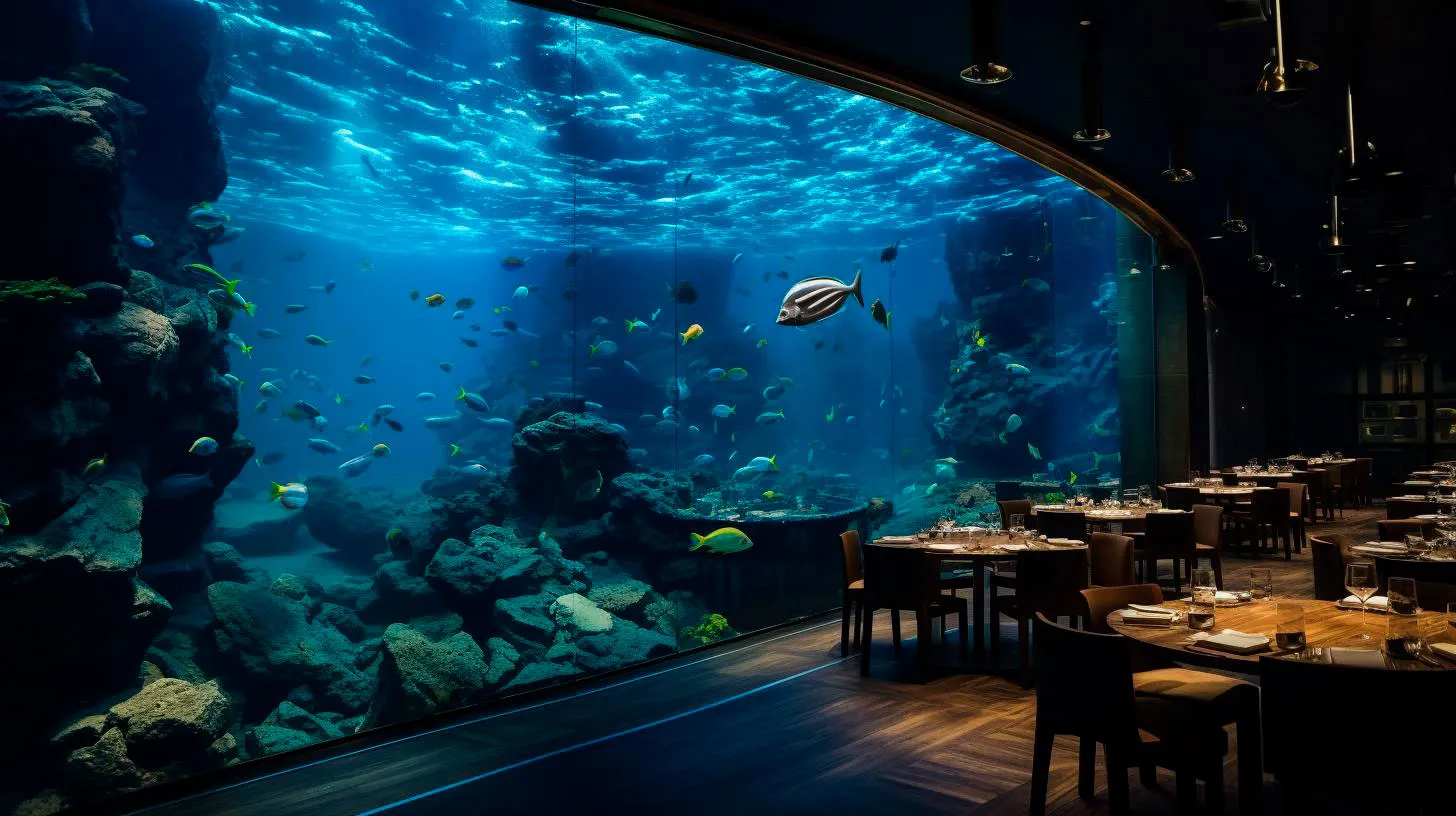From Farm to Plate: Promoting Eco-friendly Practices in Sushi Production
In this article, we will explore how eco-friendly practices can be promoted in the sushi production industry, from the farm to the plate.
The Environmental Impact of Unsustainable Sushi Production
The sushi industry heavily relies on seafood, particularly fish like tuna, salmon, and shrimp. Overfishing has become a common problem, depleting fish populations and disrupting marine ecosystems. Additionally, the production of sushi rice requires a significant amount of water and energy, contributing to environmental degradation.
Key takeaway: The sushi production industry, like many other food industries, has a significant environmental impact due to overfishing and resource-intensive practices.
Implementing Sustainable Aquaculture Practices
One of the key solutions to promoting eco-friendly sushi production is the implementation of sustainable aquaculture practices. By cultivating fish in controlled environments instead of depending solely on wild catch, we can reduce the pressure on natural fish populations. Sustainable aquaculture aims to minimize environmental impacts by focusing on efficient resource utilization, waste management, and biodiversity conservation.
Key takeaways:
- Sustainable aquaculture practices can reduce the strain on wild fish populations and their ecosystems.
- Efficient resource utilization, waste management, and biodiversity conservation are important aspects of sustainable aquaculture.
Sourcing Responsibly
Another crucial aspect of promoting eco-friendly sushi production is sourcing seafood responsibly. By supporting sustainable seafood suppliers, sushi restaurants can help protect vulnerable species and ensure the longevity of fish stocks. Responsible sourcing involves considering factors such as fishing methods, catch limits, and the impact on marine habitats.
Key takeaways:
- Supporting sustainable seafood suppliers helps protect vulnerable species and ensure the longevity of fish stocks.
- Responsible sourcing involves considering factors such as fishing methods, catch limits, and the impact on marine habitats.
Reducing Food Waste and Improving Energy Efficiency
Stemming food waste and improving energy efficiency are essential in promoting eco-friendly sushi production practices. Restaurants can implement various strategies to reduce waste, such as accurate portioning and sourcing local ingredients to minimize transportation-related emissions. Additionally, adopting energy-efficient technologies can significantly reduce the environmental footprint of sushi production.
Key takeaways:
- Reducing food waste and improving energy efficiency are crucial for sustainable sushi production.
- Accurate portioning, sourcing locally, and adopting energy-efficient technologies are effective strategies to minimize waste and energy consumption.
Educating Consumers
Lastly, educating consumers plays a vital role in promoting eco-friendly sushi production. By raising awareness about sustainable seafood choices, responsible sourcing, and the environmental impact of sushi production, consumers can make informed decisions when choosing sushi restaurants. Encouraging sustainable practices through marketing campaigns and providing information about certifications helps consumers support businesses that prioritize the environment.
Key takeaways:
- Educating consumers about sustainable seafood choices and responsible sourcing empowers them to make environmentally conscious decisions.
- Marketing campaigns and certifications can help businesses showcase their eco-friendly practices, attracting environmentally conscious consumers.
The Future of Eco-friendly Sushi
As awareness of environmental issues grows, the sushi industry is beginning to embrace eco-friendly practices. Sustainable sushi restaurants are emerging, prioritizing responsible sourcing, sustainable aquaculture, and energy-efficient operations. Governments and NGOs are also taking steps to regulate the industry and promote sustainable practices.
By embracing a farm-to-plate approach, promoting sustainable aquaculture, responsibly sourcing seafood, reducing food waste, and educating consumers, the sushi production industry can move towards a more environmentally friendly future.
Key takeaway: The adoption of eco-friendly practices in sushi production is essential to address the environmental impact and ensure the longevity of this beloved cuisine.
In Conclusion
Sushi production has a significant environmental impact, mainly due to overfishing and resource-intensive practices. However, by implementing sustainable aquaculture practices, responsibly sourcing seafood, reducing food waste, and educating consumers, the sushi industry can promote eco-friendly practices and ensure the long-term sustainability of this beloved cuisine.
Sustainable Sushi: How the Seafood Industry Can Protect the Environment
In this article, we will explore the steps the seafood industry can take to ensure sustainable sushi and the positive impact it can have on the environment.
The Unsustainable Side of Sushi
Although sushi is widely loved, the industry’s current practices often contribute to overfishing, habitat destruction, and the depletion of marine species. Here are some key issues that need to be addressed:
- Overfishing: Due to increasing global demand for sushi, many fish species population have been overexploited, threatening their survival and disrupting the oceanic food chain.
- Habitat Destruction: Fishing methods such as bottom trawling and dredging destroy vital marine habitats, such as coral reefs and seafloor ecosystems, leading to long-term ecological damage.
- Bycatch: Non-targeted marine species, including turtles, dolphins, and seabirds, often get trapped in fishing nets, resulting in their injury or death.
- Chemical Pollution: The use of harmful chemicals like pesticides and antibiotics in fish farms pollute the surrounding waters, contaminating not only the fish but also the entire ecosystem.
The Path to Sustainable Sushi
Recognizing the urgent need to protect our oceans, the seafood industry has started taking steps towards sustainability. By implementing the following measures, we can help make sushi more sustainable:
1. Supporting Sustainable Fishing Practices
Choosing seafood from sustainable sources is crucial. Look for labels such as the Marine Stewardship Council (MSC) or the Aquaculture Stewardship Council (ASC), which guarantee that the seafood comes from well-managed, environmentally responsible fisheries.
Key Takeaway: By selecting seafood with certification from reputable organizations, you can contribute to sustainable fisheries and encourage more responsible practices.
2. Promoting Aquaculture Innovation
Aquaculture, or fish farming, can provide a sustainable alternative to wild-caught fish. Encouraging innovation within aquaculture systems, such as closed-loop recirculating systems and land-based aquaculture, can minimize the environmental impact.
Key Takeaway: By supporting responsible aquaculture, we can reduce the strain on wild fish populations and ensure a more sustainable supply of seafood.
3. Reducing Food Waste
About one-third of the world’s food is wasted each year, and seafood is no exception. Reducing food waste not only conserves resources, but it also reduces the demand for seafood, consequently relieving pressure on the oceans.
Key Takeaway: By practicing mindful consumption and reducing food waste, we can contribute to the sustainability of the seafood industry and protect our oceans.
4. Educating Consumers
As consumers, our choices have a significant impact on the seafood industry. Raising awareness about sustainable fishing practices, responsible sourcing, and the importance of choosing sustainable seafood is crucial in driving change.
Key Takeaway: Educated consumers play a pivotal role in supporting sustainable practices. By making informed decisions, we can drive demand for sustainable sushi and encourage positive change across the industry.
The Benefits of Sustainable Sushi
Adopting sustainable practices in the seafood industry can have far-reaching benefits, both for the environment and for future generations:
- Preservation of Marine Ecosystems: By fishing responsibly and protecting marine habitats, we can ensure the long-term health and biodiversity of our oceans.
- Promotion of Ethical Practices: Sustainable fishing practices prioritize the welfare of marine life and reduce the environmental impact, promoting ethical and responsible seafood consumption.
- Securing Global Food Supply: Sustainable fishing and aquaculture methods can ensure a reliable and sustainable supply of seafood to meet the increasing global demand.
- Economic and Social Benefits: Sustainable seafood practices support local communities that depend on fishing, contributing to economic stability and the preservation of cultural heritage.
Conclusion
Sustainable sushi is not only a delectable dining option but also an important step towards protecting our oceans and the delicate balance of marine ecosystems. By supporting sustainable fishing practices, encouraging aquaculture innovation, reducing food waste, and educating consumers, we can make a significant impact on the environment. Embracing sustainability in the seafood industry will ensure that future generations can continue to enjoy the delights of sushi without compromising the health of our oceans.
Expanding the Sustainable Menu: Innovations and Initiatives in Sushi Sustainability
In this article, we will explore the various initiatives and menu innovations that are shaping the future of sushi sustainability.
The Importance of Sustainable Sushi
Sushi, a beloved Japanese cuisine, has gained immense popularity worldwide. However, the rising demand for fish and other ingredients has put immense pressure on our oceans and marine ecosystems. Sustainable sushi aims to address this concern by promoting responsible fishing practices, reducing waste, and supporting local communities.
Key Takeaways:
- Sustainable sushi is essential for preserving marine ecosystems.
- It promotes responsible fishing practices and supports local communities.
- Reducing waste is a crucial aspect of sustainable sushi.
Innovations in Sustainable Sushi
1. Plant-Based Sushi:
One of the most significant innovations in sustainable sushi is the rise of plant-based alternatives. By replacing traditional fish and seafood with plant-based ingredients, such as tofu, mushrooms, or jackfruit, chefs can create delicious and eco-friendly sushi rolls. Not only does this reduce the demand for overfished species, but it also appeals to the growing number of consumers embracing a vegan or vegetarian lifestyle.
Key Takeaways:
- Plant-based sushi reduces the demand for overfished species.
- Appeals to the increasing number of vegan and vegetarian consumers.
- Offers endless possibilities for creative and tasty sushi rolls.
2. Sustainable Sourcing:
Sushi restaurants are putting a greater emphasis on sourcing their ingredients sustainably. This includes partnering with local fishmongers who follow responsible fishing practices or obtaining certifications from reputable organizations like the Marine Stewardship Council (MSC). Sustainable sourcing ensures that the fish used in sushi are caught using methods that minimize harm to marine life and maintain healthy fish populations.
Key Takeaways:
- Partnering with responsible suppliers helps support sustainable fishing practices.
- Fish with MSC certification guarantees the use of responsible fishing methods.
- Sustainable sourcing contributes to maintaining healthy fish populations.
3. Zero-Waste Initiatives:
Another critical aspect of sushi sustainability is reducing waste. Sushi restaurants are implementing zero-waste initiatives by repurposing food scraps, using biodegradable packaging, and encouraging customers to bring their own reusable containers. These practices help minimize the environmental impact of sushi consumption and contribute to a more sustainable future.
Key Takeaways:
- Zero-waste initiatives reduce the environmental impact of sushi consumption.
- Repurposing food scraps and using biodegradable packaging promotes sustainability.
- Encouraging reusable containers decreases single-use plastic waste.
Statistics Highlighting Sushi Sustainability
Let’s take a look at some statistics that emphasize the importance of sushi sustainability:
– According to the World Wildlife Fund (WWF), one in three fish stocks is overfished.
– The global seafood industry generates over 170 billion pounds of waste every year (Greenpeace).
– Sustainable seafood is projected to reach a market value of $14.05 billion by 2025 (Grand View Research).
Conclusion
Sushi sustainability is rapidly gaining momentum, and the industry’s dedication to finding innovative solutions is commendable. Through plant-based alternatives, sustainable sourcing, and zero-waste initiatives, sushi restaurants are paving the way for a more environmentally conscious future. By supporting these initiatives and making sustainable choices in our sushi consumption, we can contribute to preserving our oceans and the delicate balance of marine ecosystems.
The Hidden Consequences: Examining the Environmental Impact of Sushi Consumption
The Sushi Boom and Its Environmental Toll
In recent decades, sushi has experienced a global boom in popularity. With sushi restaurants and takeout options spreading from Tokyo to New York City, the demand for sushi-grade fish has skyrocketed. This soaring demand comes with a hefty price tag on our oceans.
1. Overfishing: One of the most significant environmental consequences of sushi consumption is overfishing. Popular sushi fish, such as tuna, salmon, and eel, are under immense pressure due to overexploitation. According to the Food and Agriculture Organization of the United Nations, approximately 33% of global fish stocks are overfished.
2. Bycatch: Another hidden consequence of sushi consumption is the bycatch caused during fishing. Bycatch refers to the unintentional capture of non-targeted species, including dolphins, turtles, and sharks. It is estimated that for every pound of shrimp caught, up to 15 pounds of bycatch are discarded.
3. Carbon footprint: Sushi’s impact goes beyond the oceans. The transportation of sushi ingredients from fishing grounds to seafood markets, distribution centers, and eventually sushi restaurants comes with a significant carbon footprint. The emission of greenhouse gases contributes to climate change and further damages our environment.
Conscious Consumption: The Key to Minimizing Impact
As sushi lovers, we have the power to make a difference. By making small changes in our consumption habits, we can help minimize the environmental impact of sushi consumption. Here are a few key takeaways:
1. Choose sustainable options:
- Look for sushi restaurants that prioritize sustainability and source their fish responsibly.
- Opt for sustainable sushi options, such as those labeled with the Marine Stewardship Council’s blue fish label or the Seafood Watch’s green rating.
- Explore vegetarian or plant-based sushi options that do not rely on fish as the main ingredient.
2. Support sustainable fishing practices:
- Encourage sustainable aquaculture methods that prioritize the health of fish populations and ecosystems.
- Support organizations and initiatives working towards sustainable fishing practices and conservation efforts.
3. Reduce food waste:
- Order only what you can eat to avoid contributing to food waste. This reduces the demand for excessive fishing.
- If you have leftovers, take them home and enjoy them later, reducing both waste and your ecological footprint.
The Need for Balanced Choices
While it’s important to recognize the environmental impact of sushi consumption, it’s equally crucial to strike a balance between enjoying this culinary delight and making conscious choices. By being aware of the consequences and opting for sustainable alternatives, we can continue to relish sushi while protecting our oceans.
By examining the hidden consequences and taking action, we can create a sustainable future for sushi lovers and the environment alike. Together, let’s appreciate the flavors of sushi without compromising the health of our planet.



